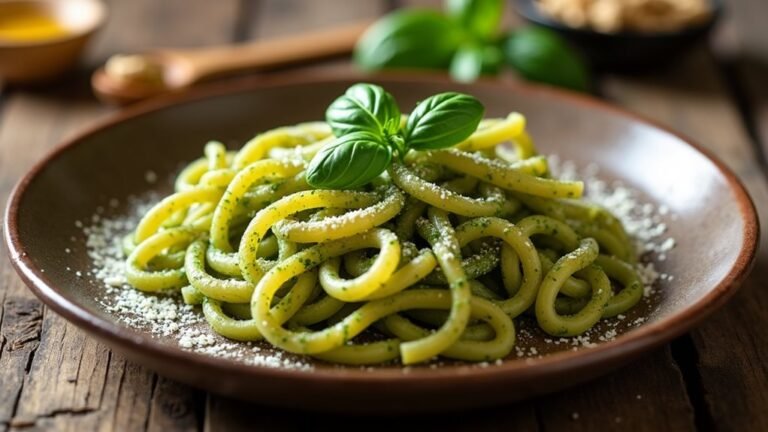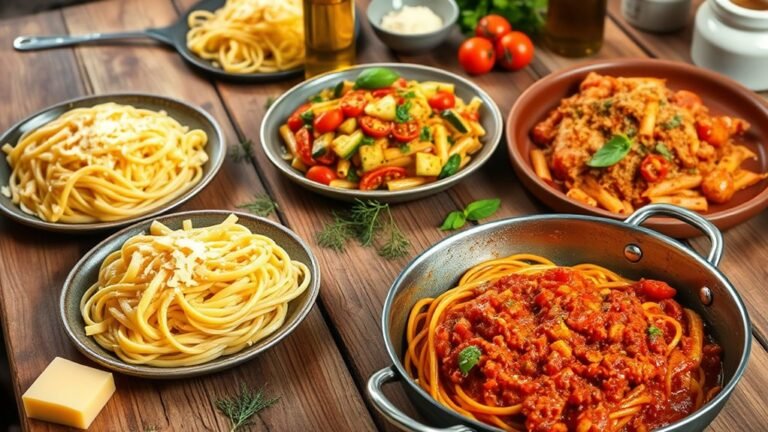Pasta Al Pomodoro Recipe: A Simple Italian Classic
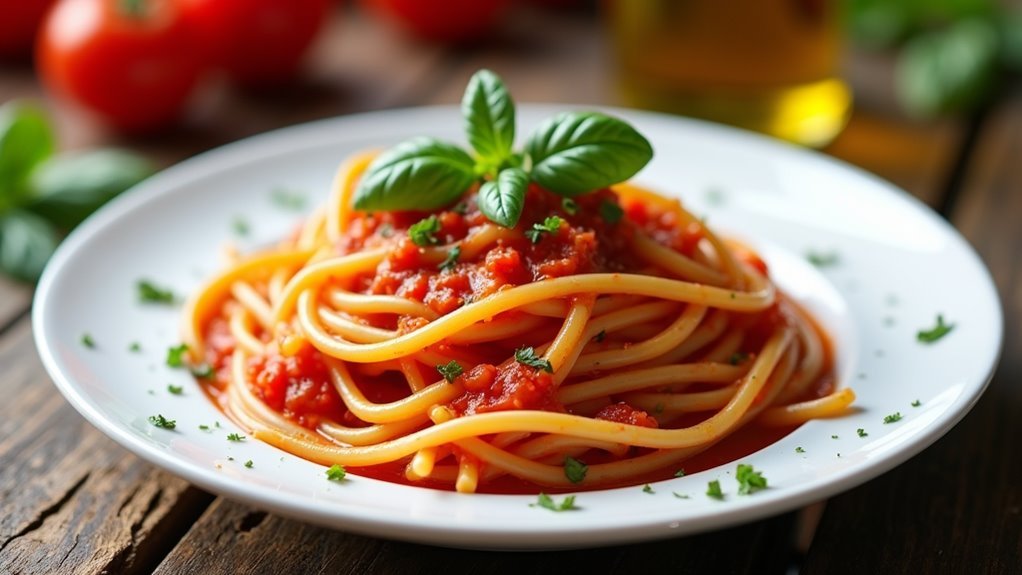
You might think Pasta al Pomodoro lacks excitement, but its beauty lies in the simplicity and depth of flavor from fresh ingredients. The right balance of ripe tomatoes, garlic, and basil transforms into something extraordinary. The secret isn't complex techniques but the quality of each component, especially the tomatoes and olive oil. For authentic Italian taste in your kitchen, there's more to explore in this timeless recipe.
Key Takeaways
- Use 1 pound of spaghetti and 6 ripe tomatoes or 28 oz canned whole peeled tomatoes.
- Sauté 4 minced garlic cloves in 1/4 cup of extra virgin olive oil until fragrant.
- Simmer tomatoes for 15-20 minutes before adding 1 cup of fresh torn basil leaves.
- Boil pasta in generously salted water and avoid rinsing after draining.
- Toss cooked spaghetti with tomato sauce, using reserved pasta water to adjust consistency.
Recipe
Pasta al Pomodoro is a quintessential Italian dish that embodies the beauty of simplicity. This recipe highlights the fresh, vibrant flavors of ripe tomatoes and aromatic basil, combined with perfectly cooked spaghetti, to deliver a timeless culinary experience. The essence of this dish lies in the quality of its ingredients, making it imperative to choose only the best for an authentic taste. Whether you're using fresh summer tomatoes or opting for high-quality canned ones, the key is to let the natural sweetness and acidity of the tomatoes shine through.
The preparation of Pasta al Pomodoro is straightforward, yet each step is crucial in achieving a sauce that perfectly complements the pasta. As you cook, the aromas of garlic and basil will fill your kitchen, promising a delightful meal that has been cherished across generations. This recipe is designed to bring out the full potential of each ingredient, resulting in a dish that's both satisfying and refreshingly light.
Ingredients:
- Spaghetti (1 pound)
- Ripe tomatoes (6 medium) or canned whole peeled tomatoes (28 oz)
- Extra virgin olive oil (1/4 cup)
- Fresh basil leaves (1 cup)
- Garlic cloves (4)
To begin, bring a large pot of salted water to a boil and cook the spaghetti until it reaches al dente perfection. While the pasta cooks, heat the olive oil in a large pan over medium heat. Add the minced garlic and sauté until it becomes fragrant, being careful not to burn it.
Incorporate the chopped tomatoes or the hand-crushed canned tomatoes into the pan, allowing them to simmer for 15-20 minutes until the sauce thickens. Add the torn basil leaves to the sauce, stirring well to combine. Drain the spaghetti, reserving some of the pasta water, and toss the pasta with the sauce. Use the reserved pasta water to adjust the sauce's consistency as needed.
For the best results, always use generously salted water when cooking your pasta, as this enhances the overall flavor of the dish. Avoid rinsing the pasta after draining, as the starch helps the sauce cling better to the noodles. If using canned tomatoes, opt for whole peeled ones and crush them by hand for a more rustic texture.
Cooking Steps
Get ready to create a mouthwatering Pasta al Pomodoro by starting with generously salted boiling water for your spaghetti, ensuring it cooks to perfect al dente.
As your pasta boils, heat up some olive oil and sauté garlic until it's fragrant, then add your tomatoes to simmer until the sauce thickens beautifully.
Finally, stir in fresh basil, and toss the pasta with this vibrant sauce, adding a splash of pasta water for the perfect consistency that clings deliciously to every noodle.
Step 1. Boil Salted Water Generously
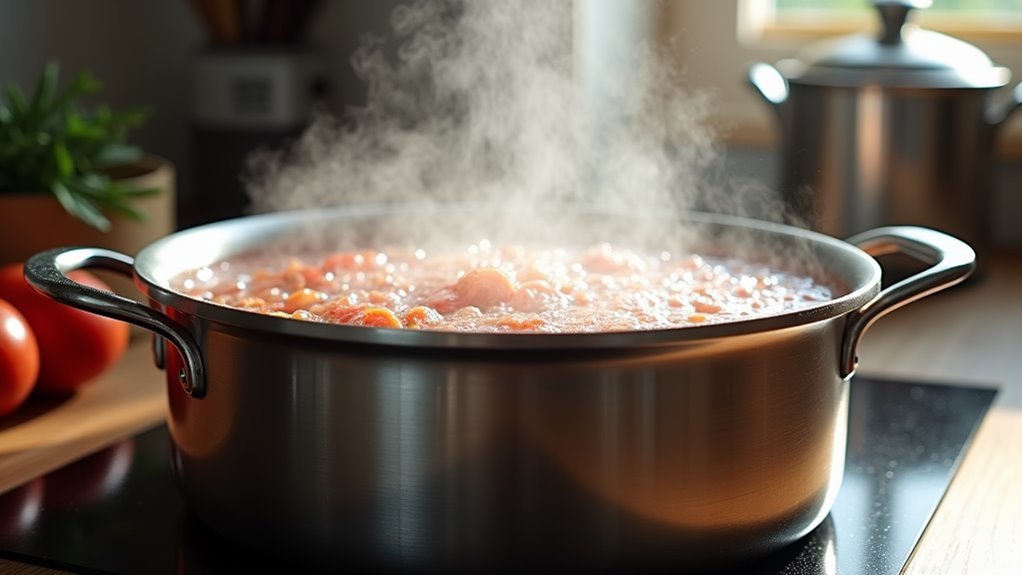
One crucial step that can make a world of difference when cooking Pasta al Pomodoro is generously salting your boiling water.
Don't hold back; it's essential for enhancing flavor. Imagine each grain of salt as a tiny flavor booster, infusing your pasta with the essence of the sea. Aim for water that tastes like a mild ocean breeze.
This step isn't just about seasoning; it's about creating a foundation for your dish. When you add enough salt, the pasta absorbs it as it cooks, ensuring every bite is delicious.
Use a large pot, so the spaghetti has room to dance around, cooking evenly. Trust me, this simple step can transform your pasta from bland to brilliant.
Step 2. Sauté Garlic Until Fragrant
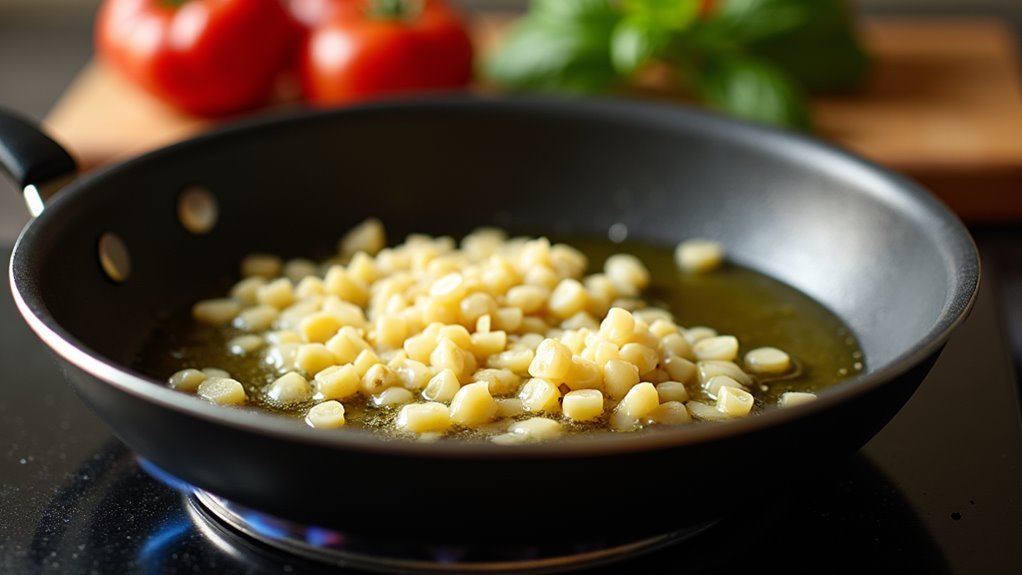
After ensuring your pasta water is perfectly salted and your spaghetti is cooking, it's time to focus on building the base of your sauce.
Begin by heating a quarter cup of extra virgin olive oil in a large pan over medium heat. This step is crucial for infusing your dish with rich, aromatic flavors.
Once your oil is warm, add four minced garlic cloves. Stir them gently, letting the heat release their irresistible fragrance.
Within a minute or two, you'll notice the garlic turning golden and filling your kitchen with its delightful aroma. Be careful not to let it burn; burnt garlic can turn bitter, altering the taste of your sauce.
This simple step ensures your Pasta al Pomodoro is truly authentic and flavorful.
Step 3. Simmer Tomatoes Until Thickened
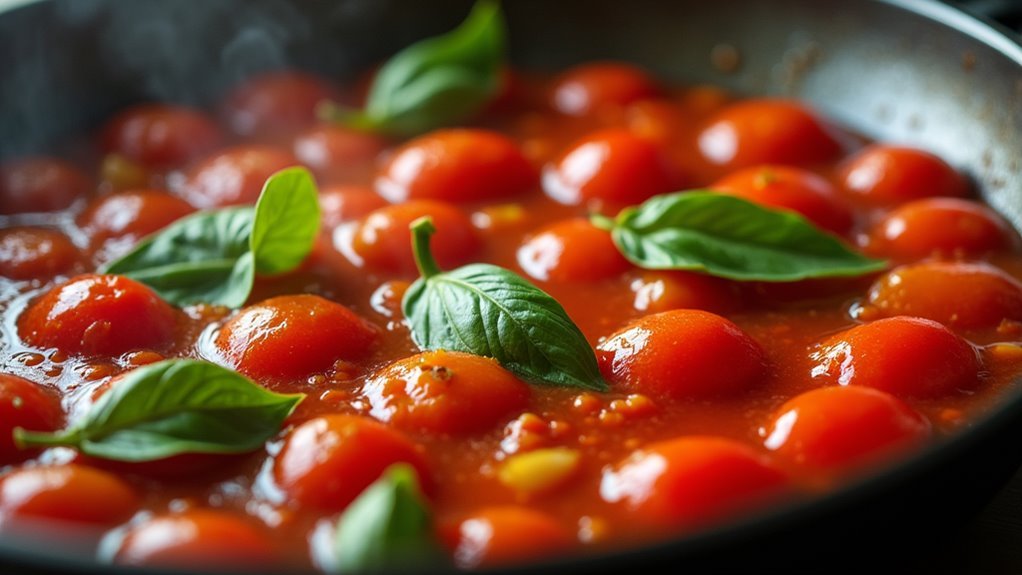
Once your garlic is perfectly golden and aromatic, it's time to introduce the tomatoes.
Pour them into the pan, letting their juicy goodness mingle with the fragrant olive oil and garlic. You'll feel the excitement as they sizzle and start to soften.
Stir gently, ensuring every piece is coated in the garlicky warmth. Keep the heat at a medium level, and watch the magic unfold.
You're aiming for a sauce that's thick and rich, which takes about 15-20 minutes. As the tomatoes break down, their flavors concentrate, creating that classic Italian taste.
Step 4. Add Basil to Sauce
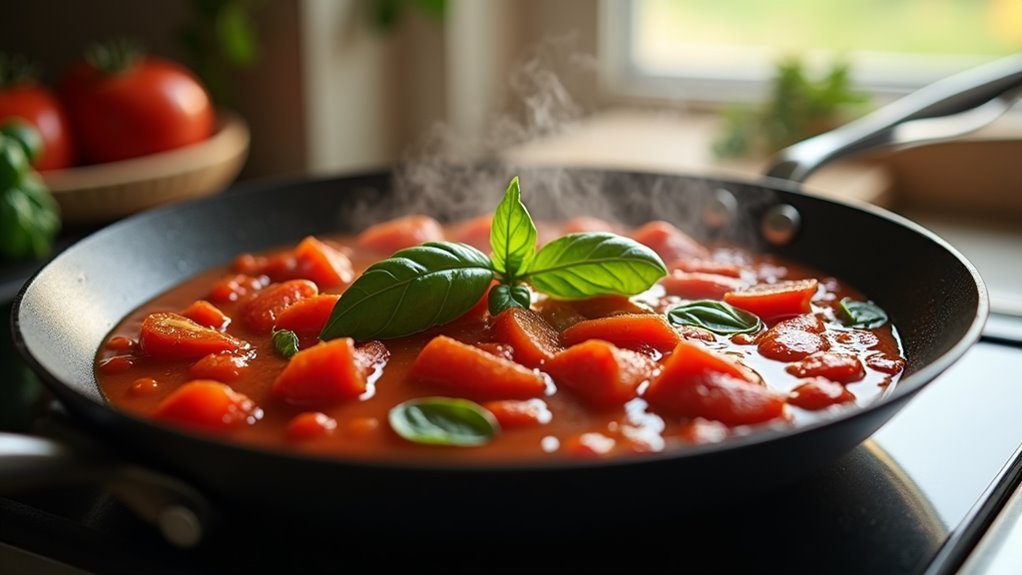
As your tomato sauce reaches that perfect velvety texture, it's the moment to introduce the fresh basil. Tear the basil leaves gently, releasing their aromatic oils, and let them fall into the bubbling sauce. Stir them in, watching how they transform the sauce with their vibrant color and fragrant aroma.
This simple addition elevates your dish, infusing it with that quintessential Italian flair. The basil's sweet, peppery notes perfectly complement the rich tomatoes, creating a harmony of flavors.
Let it simmer just briefly to meld the tastes but not lose the basil's freshness. This step is key to capturing the essence of Italian cooking, where fresh ingredients shine.
You'll find yourself smiling as the kitchen fills with the scent of an Italian trattoria.
Step 5. Toss Pasta With Sauce
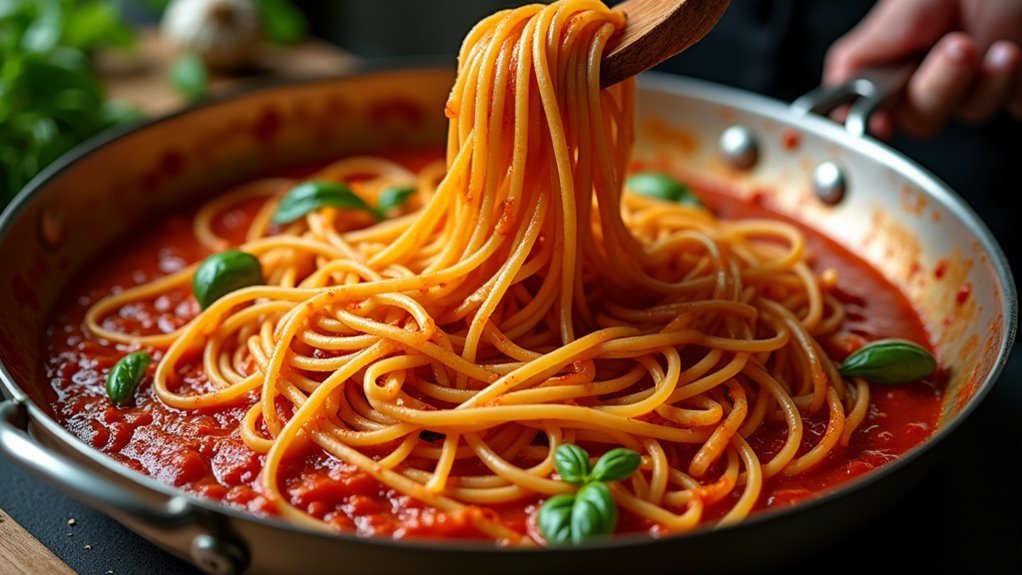
With your sauce ready and the pasta cooked to al dente, it's time to combine the two into a harmonious dish.
Pour the drained pasta directly into the pan with the simmering sauce, ensuring every strand is coated with that vibrant tomato goodness. Use tongs to gently toss the pasta, allowing the sauce to cling to each piece.
If you find the sauce a bit thick, don't hesitate to add a splash of reserved pasta water. This will help achieve that perfect silky consistency.
Toss in a handful of fresh basil leaves for a fragrant finish. As the aroma fills your kitchen, you'll feel like an Italian chef.
Enjoy this simple yet delightful creation that showcases the beauty of fresh ingredients!
Final Thoughts
Ultimately, mastering Pasta al Pomodoro is about appreciating the beauty of simplicity in cooking.
You've learned to combine quality ingredients, creating a dish that bursts with fresh flavors. This recipe isn't just about the steps; it's about connecting with the heart of Italian cuisine.
When you bring together ripe tomatoes, fragrant basil, and perfectly cooked pasta, you're crafting more than a meal—you're creating a culinary experience.
Don't hesitate to experiment with your own twist, maybe by adding a sprinkle of parmesan or a dash of chili flakes for some heat.
The joy of this dish lies in its versatility and ease. Embrace the process, savor each bite, and enjoy the satisfaction of making a classic Italian favorite at home.
Frequently Asked Questions
Can I Use Dried Basil Instead of Fresh Basil?
You can definitely use dried basil instead of fresh basil, but fresh adds an amazing burst of flavor.
When using dried, remember it's more concentrated, so you'll need less. Start with about a tablespoon and adjust to taste.
It won't deliver the same vibrant aroma as fresh, but it still brings warmth and depth to your dish.
Go ahead, experiment, and enjoy the delightful flavors that dried basil can still bring!
What Type of Olive Oil Is Best for This Recipe?
You're gonna want to go for extra virgin olive oil, the Cadillac of olive oils!
Its rich flavor and fruity aroma elevate the dish to new heights, making it a star on your dinner table.
When you heat it up with garlic, the aroma fills your kitchen like a symphony of Mediterranean scents.
Choose a high-quality bottle, as this oil will wrap your pasta in a velvety coat, enhancing every bite.
Enjoy the culinary magic!
How Can I Make This Dish Gluten-Free?
To make this dish gluten-free, swap out regular pasta for gluten-free pasta, readily available at most grocery stores.
Follow the package instructions for cooking, ensuring it's al dente for that perfect texture. You won't miss out on flavor, as gluten-free options have greatly improved!
Continue with the same delicious sauce, and you'll have a classic dish that's both satisfying and safe for anyone avoiding gluten.
Enjoy your Italian masterpiece!
Can I Add Protein Like Chicken or Shrimp to the Recipe?
Absolutely, you can add protein like chicken or shrimp to this recipe!
Just cook your chosen protein separately in a bit of olive oil, season with salt and pepper, and mix it in while the sauce simmers.
Chicken adds a hearty touch, while shrimp brings a delightful, seafood twist.
This not only enhances the flavors but also makes the dish more filling.
Dive into this tasty adventure and elevate your meal!
What Wine Pairs Well With Pasta Al Pomodoro?
You're in for a treat when pairing wine with this dish! Opt for a light, crisp white wine like Pinot Grigio or a fresh, fruity red such as Chianti.
These wines complement the fresh tomato sauce beautifully, enhancing the basil and garlic flavors.
Don't be afraid to try both to see which one delights your palate more. This pairing elevates your dining experience, making every bite a memorable journey in Italian cuisine.
Enjoy!


